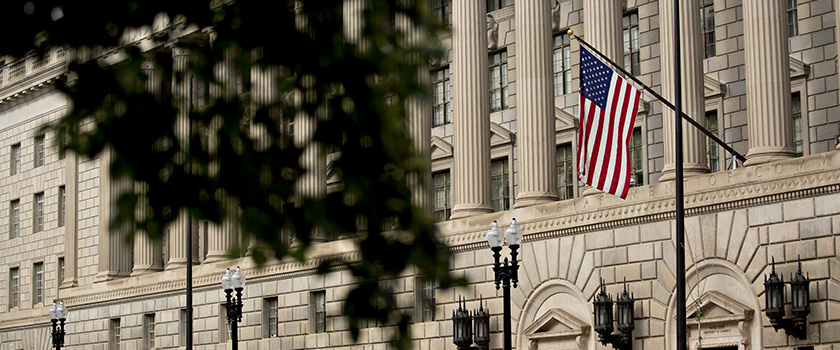US national government debt-to-GDP reached 120% in 2023, recapturing the level seen following years of wartime spending in 1945.
Though the long history of American fiscal profligacy without incident brings some investors comfort, International Monetary Fund research highlights that such over-indebtedness has been, ‘[…] at the root of many […] crises experienced by member countries’ that have required IMF intervention.
In the case of the United States, the IMF itself and US officials have cited the growing US debt burden as a concern. The non-partisan, US Congressional Budget Office director warned as recently as February 2024 that ‘[…] rising interest costs […] pose a risk to [US] economic stability’ with current interest expenses of the US Treasury reaching 15% of tax receipts, levels last seen in the early-1980s following the fiscal largesse under former US President Reagan.
Typically in such instances, the IMF-prescribed programmes have focused on ‘strong belt-tightening’ and ‘structural reforms’.
A 2023 analysis by the non-partisan Committee for a Responsible Federal Budget highlights the political and economic challenge in reducing American deficits. The Committee estimates that it would take a 27% across-the-board cut of US federal spending to balance the budget.
Given the current political division in the United States, dramatic budget cuts or tax increases of that extent seem unlikely to pass a divided US Congress to solve America’s problem. That said, we have seen two notable periods where the executive and legislative branches of the US government have come together in the past.
With the US government’s Social Security Trust Fund set to exhaust its funding in the early-1980s, a bipartisan commission, led by former US Federal Reserve Board Chair Alan Greenspan, was able to secure tax increases, benefit reductions, and a change in the retirement age to restore solvency to the Fund (through to the early-2030s based on current estimates), preventing it from calling on the US government budget to fund the American retirement programme directly.
In the early 1990s, with the US recovering from recession, the US budget deficit reached 5% of GDP, at the time one of the largest in the post-war era and only slightly smaller than the current deficit of 6% of GDP. Following on from the tax increases of his predecessor, George H.W. Bush, then-US President Clinton raised taxes again, adding nearly USD 180 billion in revenues just as defence spending obligations fell following the end of the Cold War. These tax changes and the decline in one of the largest budget line items allowed the early decade deficit to become multi-year surpluses by the late-1990s.
Admittedly, the extremity of the current political divide may preclude such wide-ranging solutions, especially in an election year.
Instead, investors should expect changes to tax policy, admittedly modest relative to some of the harsh fiscal austerity imposed by IMF programmes, though, once the political grandstanding of the November 2024 election has passed.
Beyond this, current US President Joe Biden appears to be seeking to take a page from the Clinton strategy of the 1990s. While tax receipts and the ‘peace dividend’ following the end of the Cold War were instrumental in reducing the deficit, the IT/outsourcing-driven productivity boom in the US economy of the 1990s provided a third pillar to driving growth and achieving fiscal security.
The new US industrial policy codified in the US Infrastructure, CHIPS, and the Inflation Reduction Acts of 2022 appears to have kicked off the early stages of an investment boom, not unlike the one seen in the 1980s that led to the productivity boom of the 1990s. Admittedly, the lags of such investments tend to be long. However, after more than a decade of weak fixed investment growth following the global financial crisis, the new policies appear designed to recapture medium-term productivity growth within the domestic economy.
Thus, with only moderate bipartisan changes to tax policy probable and the benefits of 2022’s industrial policy legislation likely only to be realised later in the decade, American policymakers will need to deploy additional tools to buy time to both ensure debt sustainability and contribute to the deleveraging of the sovereign balance sheet in the interim.
The US Federal Reserve appears to have already begun to deploy one of these tools, slowing the pace of the American central bank’s unwinding of its US Treasury holdings. Recall, on 1 May, the Federal Open Market Committee indicated it would shrink the roll-off of its US Treasury holdings from USD 60 billion to USD 25 billion per month, bringing an additional USD 420 billion in demand annually for US government debt from the Fed itself.
This demand should help American policymakers to implement another strategy, keeping Treasury yields below the rate of nominal GDP growth. Recall, amidst the euro sovereign debt crisis, with Italy near deflation and showing little real growth, the European Central Bank’s bond purchases helped push Italian yields to converge with nominal GDP growth, preventing Italian debt-to-GDP from rising too rapidly and helping the nation avoid the outcome that engulfed its neighbour to the east, Greece.
The recent American policy pivot, even as headline CPI remains above 3%, raises the risk looking ahead that elevated inflation also becomes part of the policy objectives as a driver to maintain elevated nominal GDP growth. However, even here, the US must be cautious, as Social Security and Medicare are both significant outlays that are indexed to inflation, limiting the potential deleveraging benefits for the economy.
Indeed, while the post post-WWII US deleveraging saw US debt-to-GDP peak near 120% before falling to 23% by 1974, work from Julien Acalin of the IMF and Laurence Ball of Johns Hopkins University examining this deleveraging provide another warning. Their work highlights that relying heavily on this interest rate relative to inflation/nominal growth strategy rather than combining it with ‘strong belt-tightening’ such as typically prescribed by the IMF may prove ineffective.
Thus, investors should look forward to US policymakers continuing to buy time using above-trend inflation and nominal growth, while containing a full repricing of these risks on bond yields in order to move beyond the election-related gridlock in policymaking and potentially realise productivity benefits from the investment surge in recent years.
For bond investors, managing the risk that these developments unfold in a disorderly manner should remain a priority. As a result, with the prospect of higher interest rate volatility than experienced historically, a focus on income (i.e. carry) strategies is preferred to moderate- and even long-duration interest rate risk in portfolios. Moreover, with the prospect of higher-than-target inflation expectations persisting as a policy objective, inflation-protected securities should likewise offer shelter for investors as US policymakers address their fiscal overreach in the years ahead.









